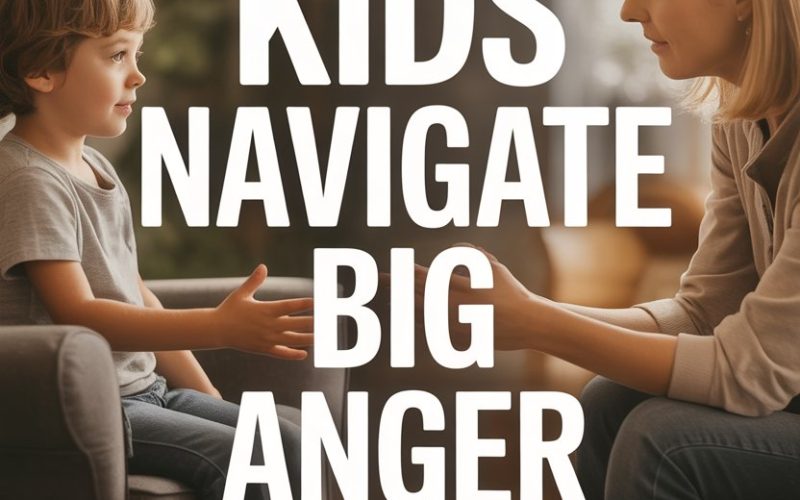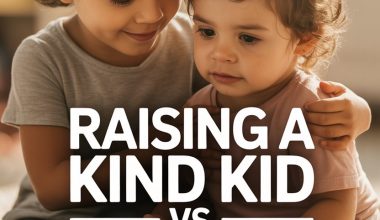If you’ve ever watched your child turn from cherub to T. rex in the space of a breath, welcome to the club.
Big anger moments are part of parenting—right up there with stepping on Lego and negotiating broccoli intake.
The trick isn’t making anger vanish (if only). It’s helping kids learn to handle those volcanic feelings without blowing the roof off your house.
Here’s how busy parents can help their kids through those wild, stompy, door-slamming moments—using strategies that don’t involve hiding in the pantry with chocolate (at least not always).
Everyone Gets Angry—Even the Sweetest Kid
Anger is a normal, healthy emotion. Kids get angry for the same reasons we do: things feel unfair, they’re exhausted, someone took their stuff, or the universe isn’t cooperating (again).
What’s different? Their brains are still under construction.
Neuroscientists explain that children’s prefrontal cortex—the bit responsible for impulse control and rational thinking—runs on dial-up while their emotional brain is pure broadband.
Translation: your six-year-old’s meltdown at the supermarket checkout is developmentally normal. According to child psychologist Dr. Laura Markham, “Kids aren’t giving you a hard time, they’re having a hard time.”
Spotting the Volcano Before It Blows
You know the warning signs: clenched fists, red cheeks, that laser glare. Catching anger before it erupts helps kids learn to manage it.
Try saying what you see: “Your face is getting scrunched up. Are you starting to feel really mad?”
Labelling the feeling helps kids step back just enough to stop the lava flow.
This early intervention works a treat for younger kids, who often don’t recognise what’s happening in their own bodies.
It’s not magic, but it turns out acknowledging feelings out loud (“You look really angry your sister took your toy”) is backed up by research from the University of California, Los Angeles, which found that naming emotions can actually calm the brain.
Stay Calm—Even When You’re Seeing Red
Kids borrow our emotional weather. When you keep your cool (even if you’re silently chanting “Serenity now”), you’re showing your child what emotional regulation looks like.
That doesn’t mean you’re a robot. If you’re struggling, it’s fine to say, “I need a minute to calm down before we talk.”
Parents who model calmness send the message that all feelings are allowed, but not all behaviours. This keeps you in the role of guide—not adversary. (Bonus: shouting matches are lousy for everyone’s blood pressure.)
Set Clear Boundaries with a Side of Empathy
A favourite parenting myth is that empathy means you let your child get away with murder.
In reality, you can be both compassionate and firm. “I see you’re really angry you can’t have ice cream for breakfast. It’s okay to be mad. It’s not okay to throw your bowl.”
Notice the order here: acknowledge the feeling, then set the limit.
Over time, this approach helps kids feel heard, even when they don’t get what they want. It also gives them a script for the future: “I’m angry, but I can’t hit.”
Teach Anger Management Tools Before the Storm
When your child is in the thick of big feelings, they can’t learn new skills. That’s like asking someone to memorise a new recipe while their kitchen’s on fire.
Instead, cover strategies for handling anger when everyone’s calm.
Try brainstorming together: What helps you feel less angry? Some kids like squeezing a pillow or stomping feet, others prefer drawing or taking deep breaths.
The “Take 5” breathing technique—tracing fingers while breathing in and out—works for many. The key is finding what fits your child’s temperament.
Dr. Dan Siegel, a clinical professor of psychiatry, suggests helping kids “name it to tame it.” The act of identifying feelings and having a plan (like counting to ten or asking for space) boosts self-control over time.
Create a Cool-Down Space (Not a Punishment Corner)
Forget the “naughty step.” Instead, offer a “calm-down corner” or “peace tent”—a spot with soft cushions, books, or even a stuffed animal that’s seen better days.
This isn’t a penalty box; it’s a safe space where kids can reset.
Invite your child to use it when anger’s building (“Do you want to try your calm spot?”), but don’t force it. Over time, the calm-down space becomes a tool, not a threat.
And yes, you’re allowed to use it too. No shame in hiding behind a pile of plushies for a minute.
Connect After the Storm
Once the anger hurricane has passed and everyone’s back in the land of the reasonable, it’s time for connection.
This isn’t about rehashing the drama or giving a lecture. It’s about reassurance: “Big feelings can be scary. I love you, even when you’re angry.”
Try a “repair conversation” where you talk through what happened, what could be different next time, and how you both felt. This process builds trust and helps kids see that messy feelings don’t wreck relationships.
Psychologist Dr. Becky Kennedy calls this the “magic of repair”—the glue that holds families together.
Know When to Get Extra Support
Sometimes big anger moments are more than just a phase.
If your child’s anger feels out of control, is causing harm to themselves or others, or is interfering with school, it’s worth checking in with your GP or a child psychologist. There’s no shame in seeking help.
Apps like Smiling Mind or Headspace for Kids can introduce mindfulness in a kid-friendly way.
Books such as “When Sophie Gets Angry—Really, Really Angry…” by Molly Bang can open conversation about tricky feelings.
And don’t underestimate the power of a supportive parent WhatsApp group—sometimes another adult’s “Me too!” is the best medicine.
Your Child Isn’t Broken. They’re Learning
Anger isn’t a sign of a bad kid or a bad parent. It’s a sign your child is growing, stretching, and figuring out how to be a human in a world that isn’t always fair or easy.
With your support, your child can develop the skills to handle their fire—and maybe even use it for good (like standing up for themselves, or refusing to wear socks with holes).
And if you find yourself face-to-face with another meltdown tomorrow, take heart. You’re not raising a robot. You’re raising a person.
That’s messy, noisy, and—some days—absolutely marvellous.
Little Humans, Big Feelings
Every child will have those epic moments of fury: collapsed block towers, “no” at the wrong time, injustice in the form of a bedtime routine.
Your job isn’t to snuff out the anger, but to walk alongside your child as they learn what to do with it.
And if you occasionally need to retreat to the loo and count to ten yourself? You’re in excellent company.





